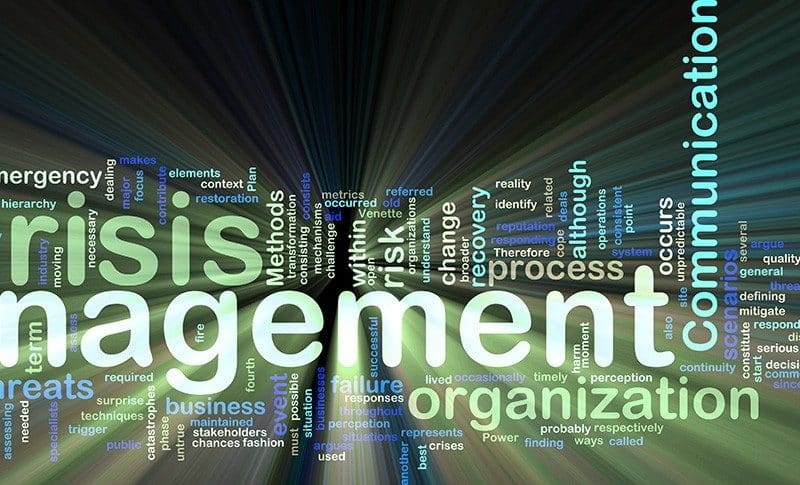The management of the crisis is a vital organizational feature. Basically, failure may cause substantial damage to stakeholders, financial losses for an entity, or even the end of its life. Public relations professionals are essential members of crisis management teams. Volumes on crisis management have been published by professionals and scholars from a variety of backgrounds. This makes it difficult to synthesize what we know about crisis management and public relations’ role in that knowledge base. The best way to begin this strategy is by identifying key concepts which include the crisis management plan, and phases.
What is a Business Crisis?
A business crisis is an occurrence that has the potential to jeopardize a company’s success and also well-being by tarnishing its image. Thus, it can cause damage to its business operations, adversely affecting its finances, or endangering its employees.
Actually, a business crisis can be triggered by either internal or external factors. Because of the magnitude of a business crisis, it is important to be prepared to tackle one of these incidents with a strategy you (and your team) build before one occurs.
What is Crisis Management?
Crisis management is the process of planning for and also handling any disruptive or unforeseen emergency situations that impact the company, stakeholders, staff, customers, and revenue. The handling of crises is an important aspect of public relations.
Now, let’s look at crisis management plans and how to build one for your business.
What is a Crisis Management Plan?
A crisis management plan is a documented procedure that a company follows when faced with a disruptive or unexpected emergency. Your crisis management plan should be completed before a crisis. This is because your company is ready to use it to combat and also rectify any unexpected events.
Why do you need a Crisis Management Plan?
If your company faces a crisis of any kind and also does not have a crisis management plan in place that outlines how you will handle the situation, serious and long-term consequences are likely. These implications may be linked to a variety of legal, organizational, and public relations concerns. Depending on the extent of the damage, a crisis might even put you out of business.
Simply put, all businesses should have a crisis management plan in place to be prepared for any unplanned event and to avoid long-term damage as a result. There are four additional major examples of why the company should have a crisis management strategy.
Crisis Management Plan:
- Assists you in maintaining your excellent reputation with customers, competitors, and industry leaders during and after a crisis.
- Improves the security, health, and well-being of everyone who works for and does business with your company.
- Gives you peace of mind as an employer and company — you’ll be prepared for any situation that arises.
- Increases productivity both during and after a crisis. During a crisis, everyone will understand their role and function, resulting in less downtime, more action, and a faster resolution.
Read Also: Crisis Communication Planning: Detailed Guide with Examples
How to make a Crisis Management Plan
Let’s go over the seven steps to developing a crisis management plan.
#1. Determine all possible types of crises.
The first step in developing a crisis management plan for your company is to identify all potential types of crises that could occur in your industry. Consider the various types of crises that businesses are most vulnerable to.
- Financial crisis: A decline in demand for anything a company sells, whether it’s a product or a service. They lose value in those assets and are unable to pay off their debt.
- Personnel crisis: This is when an employee takes part in immoral or unlawful behavior or behavior. This misconduct may occur in or out of the workplace. Also, it may be linked to the individual involved’s job or personal life.
- Organizational crisis: When a company has wronged its consumers by taking decisions that harm them. Examples involve withholding vital information from consumers who have a right to know about a particular subject or exploiting customers.
- Technological Crisis: This is when servers fail, software crashes or another technological system stops working properly. It could cause a company to lose a lot of money, make customers doubt their dependability, or tarnish their credibility.
- Natural disasters: Hurricanes, tornadoes, flooding, and winter storms are all examples of natural disasters. They have the potential to threaten or fully destroy a company’s office space (or any area owned or used by a business). Depending on a company’s venue, they can be more vulnerable to numerous natural disasters that occur during the year.
#2. Determine the effect of each form of crisis on your company.
After you’ve considered the crises that could affect your business, you’ll want to consider the effect each of these events could have on your company, staff, and customers. Here are a few examples:
- Sales decrease
- Customer disappointment
- a tarnished credibility
- Expenses rise (to fix the issue at hand)
- Customer loyalty to your brand is dwindling.
By quantifying the effect of each crisis on your company, you will be able to consider each potential angle of a hazard or disaster and, as a result, plan for it accordingly. This form of analysis will help you decide the necessary steps you and also, your coworkers can take to handle each case.
#3. Consider the steps you’d need to take to overcome each form of crisis.
Examine the various crisis management strategies available to you and your company to assess the steps you and your company will need to take to work through a crisis situation. The following are some of the most popular crisis management techniques:
- Responsive crisis management: This is when a company has a pre-planned solution to a particular form of a crisis that it can use at any time. You may use Situational Crisis Communication Theory (SCCT) to help you build this response plan so that your company is ready for any crisis.
For example, a company may have complex procedures in place to deal with an internal or financial crisis in a timely manner. These plans can also provide a description of how they intend to educate staff about the event and deal with key stakeholders.
- Proactive crisis management: This is when a company anticipates a new form of crisis and plans for it ahead of time. A business in Key West, FL, for example, should ensure that the office space is designed to withstand hurricanes and extreme storms.
- Recovery crisis management: This is when a company tackles a crisis that caught them off guard. A technological crisis is one example of this. If a company’s software works well one moment and then accidentally fails the next, it affects workers as well as people who use the software.
When you identify all of the crises that your company is vulnerable to, you can decide to create a business continuity plan at this time. This will assist you in identifying all future facets of these crises on a very comprehensive level while you move through the remainder of the crisis management plan measures.
Read Also: Risk Management Strategies: 5+ Strategies You Can Follow Now!!!
#4. Determine who will be involved in the acts that must be taken in each case.
After you’ve considered the impact of and also form of crisis and the steps you’ll take to overcome them, it’s time to consider who will carry out the required resolution plans and actions. This may include specific employees with experience in various areas of your company. It can be your HR, public relations, and anyone else you see fit based on your specific situation. Depending on the nature of the crisis, you can also decide that you need the assistance of attorneys, experts, or first responders.
#5. Create crisis-resolution plans for each type of crisis.
Working through the four steps outlined above will allow you to develop appropriate crisis resolution plans for each type of crisis. Also, each resolution plan would be unique depending on the circumstances; however, the following are some common questions to consider when designing any form of crisis resolution plan:
- How long is it likely that the crisis will last?
- What equipment and resources will you require?
- How many people, and which ones, have you decided will be involved?
- Will you have to speak directly to your customers?
- What caused the crisis, and how can you keep it from happening again (or worsening?)
#6. Educate everyone who needs to be aware of your plans.
Everyone in your crisis management plans should get training on their responsibilities. You could do this through meetings and presentations. You can also bring in experts to advise your employees on how to manage their job functions during a crisis.
Also, inform all other employees who may not play a role in resolving a crisis of the actions they are to take. For example, if your company is located in an area prone to natural disasters, training everyone on safety-related actions to take, such as where to seek shelter, is critical. The last thing you want is for one of your employees to be hurt during a crisis because of a lack of planning and training.
#7. Review and update your plans on a regular and as-needed basis.
As your company expands, you can hire more people, open offices in new cities (or countries), or alter the structure of your business operations. These are all instances where you can review and amend your crisis management plans. This is to ensure they still relate to and work with your organisation.
If your company does face a crisis, be sure to review the effects of your management plans to see if they were effective in getting your company through it. You can decide if you need to revise or rework them.
Goals of Crisis Management
The goal of crisis management is to limit the harm that crisis can inflict. Crisis management is a multi-step procedure that begins well before, during, and after a crisis occurs.
Crisis Management Teams
The Crisis management teams are established to protect the company from the negative consequences of any crisis situation or occurrence. They also assist in keeping the company and its staff prepared for any risks that might arise.
A crisis management team‘s primary job roles include:
- Identifying warning signs that indicate the impending arrival of a crisis.
- Working with staff to prepare for and carry out a crisis management strategy.
- Keeping the company’s image positive during (and after) every crisis.
- Assisting your company in preparing for any potential crisis.
There are three types of crisis management teams that your organization can employ to assist you in managing a situation. Regional emergency management teams, site emergency response teams, and company support teams are examples of these teams.
#1. Regional Emergency Management Organizations
Regional emergency response teams provide assistance to local residents in a crisis. This team can handle the region-specific consequences of a crisis, depending on the size of the company and also the number of office locations you have. This type of team is usually made up of people who already live and work in the city.
#2. Emergency Response Teams on-site
When called upon, site emergency response teams go straight to the scene of a disaster (if they are not already there when the situation unfolds). On-site staff, first responders, and municipal authorities make up this sort of unit.
#3. Business Support Groups
Business support teams handle the overall effect of a crisis on a business. It is a team of workers who ensure that all management plans to address the crisis are carried out. Furthermore, Employees from various locations and/or departments can be included in business support teams.
Risk management versus recovery crisis management
Although risk management is an important component of crisis management, crisis management typically includes incident response, whereas risk management does not.
However, risk management refers to the process of identifying and reducing hazards while crisis management entails determining the best course of action in handly situations.
Prepare Your Company for a Crisis
Making sure your company is prepared for any number of potential crises will help you to maintain a positive and professional image with your clients, rivals, and employees.
Basically, implementing a crisis management strategy, considering the various phases of a crisis, and also assembling a team of people to assist you through every unexpected incident or disaster, will protect the business from long-term, detrimental consequences.
Begin working on your management strategy and making connections with the people who will be able to help you along the way to prepare the company for any sort of crisis.
How can organizations improve their crisis management capabilities over time?
One key way organizations can improve their crisis management capabilities is by conducting regular assessments and drills. This helps identify areas for improvement and ensure that everyone on the team is familiar with their roles and responsibilities. Another important aspect is staying up-to-date on industry best practices and emerging technologies. Finally, organizations should make sure to incorporate lessons learned from past crises into their crisis management plans to continuously improve their capabilities.
How can organizations recover from a crisis?
The road to recovery after a crisis can be long and challenging, but with a well-thought-out plan in place, organizations can get back on their feet. Some important steps to consider include conducting a thorough post-crisis analysis to understand what went wrong, communicating openly and honestly with stakeholders, and taking steps to restore trust and confidence. Additionally, organizations may need to make changes to their operations, processes, and policies to prevent similar crises from happening in the future.
What is the role of the media in crisis management?
The media can play a critical role in crisis management, both as a source of information and as a means of communication. On the one hand, organizations need to be aware of what the media is reporting about a crisis, as it can help provide insights into public perception and reactions. On the other hand, organizations also need to be prepared to communicate effectively with the media, both to provide accurate information and to control the narrative. By establishing strong relationships with journalists and media outlets, organizations can better manage their reputation during a crisis.
What is the role of social media in crisis management?
Social media has become a key tool in crisis management, as it provides organizations with a platform to reach a large, engaged audience quickly and easily. During a crisis, organizations can use social media to provide updates, respond to questions, and dispel rumors. At the same time, organizations need to be mindful of the risks associated with social media, such as the spread of false information, the amplification of negative sentiment, and the potential for reputational harm. By developing a comprehensive social media strategy as part of their crisis management plan, organizations can effectively leverage this powerful tool to mitigate risk and support their recovery efforts.
How can organizations assess their crisis management readiness?
To assess their crisis management readiness, organizations can conduct a risk assessment to identify potential crisis scenarios and evaluate their current response capabilities. Additionally, organizations can conduct crisis management drills and tabletop exercises to test their plans and identify areas for improvement. Finally, organizations should regularly review and update their crisis management plans and ensure that all employees are trained and familiar with their roles and responsibilities.
What are the legal considerations in crisis management?
Legal considerations in crisis management vary depending on the nature of the crisis and the jurisdiction in which it occurs. Some common issues that organizations may need to consider include privacy laws, product liability, contracts and obligations, and regulatory compliance. It is important for organizations to consult with legal counsel when developing their crisis management plans and during a crisis to ensure they are taking all necessary legal considerations into account.
Crisis Management FAQs
What is crisis management with example?
Risk management involves planning for events that might occur in the future, crisis management involves reacting to negative events during and after they have occurred. An oil company, for example, may have a plan in place to deal with the possibility of an oil spill.
What is the role of crisis management?
The role of the Crisis Management Team is to manage events and also ensure appropriate actions are carried out based on the current impacts of the event, as well as potential risks and impacts. Multiple crisis teams may exist, with each activating and providing guidance depending on the situation.9
How do you build an effective crisis management team?
6 Steps to Creating a Capable Crisis Management Team
1 – Understand Crises. …
2 – Create the Framework and Setting Policy Direction. …
3 – Create the Plan.
4 – Develop an Incident Command System.
5 – Validate the Plan and Team. …
6 – Implement Changes and Re-evaluate
What is the first role of crisis management?
The first step is to understand the main areas of concern during emergency situations. Also, the crisis Management Team then works on the various problems and shortcomings which led to crises at the workplace.






1 comment
Great article, thanks!